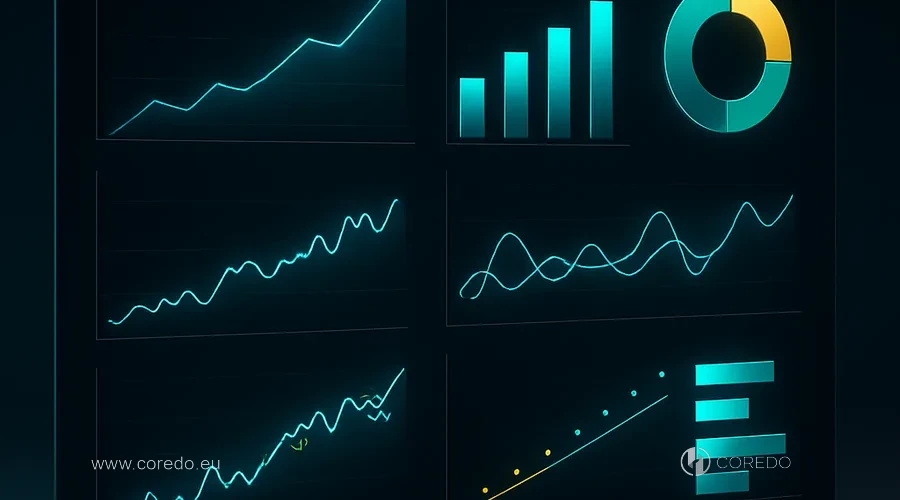You will receive practical recommendations, learn about the best technologies and methodologies, and see real cases from COREDO’s practice. If your goal is to take the bank to a new level of efficiency, be sure to read to the end: here you will find strategic ideas and tools that work.
Optimization of banking processes to increase the bank’s productivity

Optimization of banking processes becomes a key tool for increasing a bank’s productivity and its competitiveness in the market. Modern financial organizations need to review and improve their business processes to reduce costs, speed up service and increase customer satisfaction.
Optimization of business processes in banks
Any optimization begins with a thorough analysis of current processes. COREDO’s practice confirms: only detailed mapping of a bank’s business processes allows identifying bottlenecks, redundant operations and points of loss. We apply Value Stream Mapping and process audit methodologies to determine where delays, duplication of functions or inefficient allocation of resources occur.
The next stage: standardization and control of business processes. In European and Asian banks, standardization of operations according to ISO 9001 and ISO 20022 provides transparency, manageability and risk reduction. Solutions developed at COREDO include the implementation of clear regulations, control points and automated electronic document management systems (EDMS), which minimize errors and speed up transaction processing.
The third step: implementation of BPM platforms and automated banking systems (ABS). BPM in the banking sector allows not only modeling but also flexible management of a bank’s business processes, integrating front and back office, payment processing and credit operations into a single digital ecosystem. The COREDO team has implemented projects integrating platforms such as Camunda, Appian and Bizagi, which enabled clients to reduce the application processing cycle by 40% and lower operating costs by 25%.
Change management and employee engagement: a mandatory element of successful optimization. Our experience at COREDO has shown that only through training, communication and involving key employees can you ensure the sustainability of transformations, reduce resistance and accelerate the implementation of new standards.
Lean Six Sigma and methodologies for optimizing banking processes
Lean Six Sigma is one of the most effective methodologies for reducing a bank’s costs through automation and improving the quality of operations. In COREDO projects we used DMAIC (Define, Measure, Analyze, Improve, Control) to optimize lending and deposit processes, which reduced application processing time from 5 days to 36 hours.
Agile and Scrum in banking IT projects are not just buzzwords but practical tools that provide flexibility, rapid adaptation to change, and transparency in managing digital transformation projects. The COREDO team implemented Scrum to develop and integrate a CRM system in a large European bank, which expedited the product’s time-to-market and increased customer satisfaction by 20%.
Practical examples from COREDO’s experience show: the combination of Lean Six Sigma, BPM and Agile not only optimizes a bank’s business processes but also creates a culture of continuous improvement and innovation.
Automation of banking processes to improve efficiency

Automation of banking processes to improve efficiency is a strategic tool that allows banks not only to optimize internal operations but also to elevate the quality of customer service. Modern automation solutions cover both front and back office, reducing costs and minimizing errors to ensure maximum reliability and responsiveness of the entire banking system.
Thus, automation covers the key processes of both areas and opens new opportunities for comprehensive optimization of the bank’s operations.
Automation of the bank’s front and back office: what to optimize?
The front office is the bank’s face to the client. Here speed and accuracy of service, as well as communication quality, are critical. Implementing CRM systems for banks such as Salesforce, Microsoft Dynamics or Creatio enables automating request processing, segmenting customers, tracking interaction history and quickly responding to changes in demand. A solution developed by COREDO for a bank in the Czech Republic delivered a 15% increase in NPS by automating front office operations.
The back office is the heart of operational efficiency. Automation of lending and deposit operations, integration of ABS and electronic document management systems (EDMS) help reduce document processing time, decrease the number of errors and ensure process transparency. COREDO’s practice confirms:Automating payment and plastic card processing using modern platforms (for example, FIS, Temenos) increases transaction speed and reduces operational costs.
process optimization of lending and deposits, a separate area where automation enables the standardization of procedures, integration of scoring models and control of the bank’s business processes at every stage.
Integration of AI, machine learning and APIs
The integration of artificial intelligence and machine learning into banking operations is not theory but today’s reality. The COREDO team has implemented projects to deploy ML models for automating scoring, detecting fraud and predicting customer churn. Such solutions improve the accuracy of operations, reduce risks and speed up decision-making.
Integrating APIs into banking systems is the key to digital customer service channels and process scalability. Open APIs allow banks to quickly connect new services, integrate payment processing, CRM and BPM platforms, and provide an omnichannel customer experience.
data security and information security in banks are a priority for any automation. COREDO’s practice includes implementing ISO/IEC 27001 standards, regular audits, data encryption and multi-layered protection, which helps minimize the risk of information leaks and comply with regulators’ requirements.
Digital transformation and risks in banks

This is especially important against the backdrop of new digitalization trends, which we will discuss below.
Digital transformation of financial institutions, trends and challenges
Digital transformation of banks is not just the introduction of new technologies, but a comprehensive change of the business model, processes and organizational culture. In Europe and Asia, market leaders are investing in digital innovations, front- and back-office automation, integration of BPM platforms and artificial intelligence.
The impact of digitalization on customer experience cannot be overestimated. COREDO’s solutions for digitizing service channels, implementing mobile applications and chatbots have allowed banks to increase customer engagement and halve waiting times.
Best practices for optimizing banking processes in Europe and Asia include standardizing operations, integrating CRM and BPM, automating processing and continuous staff training. COREDO’s experience shows: the success of digital transformation depends on a comprehensive approach and strategic planning.
Bank risk management and compliance
Regulatory requirements and compliance in banking are becoming increasingly complex. Banks must comply with AML, KYC, GDPR and ISO standards, and integrate monitoring and reporting systems. The COREDO team has implemented projects to deploy automated compliance platforms, which has reduced the risk of fines and sped up transaction processing.
Managing operational risks in the context of digitalization requires integrating business process analytics, monitoring KPIs of banking processes and regular audits. COREDO’s solutions include control automation, the implementation of early-warning systems and staff training.
Ensuring compliance with ISO and AML standards is an integral part of optimizing a bank’s business processes. COREDO’s practice confirms: only a systematic approach to compliance and risk management ensures sustainable development and protection of the interests of the bank and its clients.
KPI and ROI of digital initiatives: efficiency metrics

KPIs and ROI become the basis for an objective assessment of the effectiveness of digital initiatives and allow not only recording the achievement of goals but also measuring the actual return from implementing new processes and solutions. Using these efficiency metrics is especially important for comprehensive analysis, for example, when evaluating the digital transformation of banking processes or new digital products.
Analysis of KPIs of banking processes
Selecting the right KPIs for banking processes is the basis for assessing the effectiveness of optimization. In COREDO projects we use metrics such as average application processing time, percentage of automated operations, customer satisfaction levels (NPS, CSAT), payment processing speed and level of operational costs.
Examples of key indicators for the front office: response time to a request, number of successfully processed inquiries, conversion rate. For the back office: document processing time, error rate, operation execution speed. For processing: transaction time, percentage of successful payments, rejection rate.
Business process analytics: a tool for continuous improvement. COREDO’s solutions include the implementation of BI platforms, automated dashboards and regular data analysis, which makes it possible to identify growth points and make informed management decisions.
Thus, comprehensive business process analytics creates a solid foundation for further assessment of the return on investment in digitalization.
Assessing the ROI of digitalizing banking processes
Assessing the ROI from digitalizing banking processes is a critically important step for strategic planning. Implementing CRM and BPM for banks, integrating AI and automating operations allow reducing costs, increasing profitability and improving the bank’s productivity.
Methods for assessing ROI include calculating time savings, reduction of operational costs, customer base growth and increased revenues from new services. COREDO’s practical cases show: integrating a BPM platform allowed one of our clients in Slovakia to increase operating margin by 18% by reducing loan application processing time and automating payment processing.
Scaling successful initiatives in international banks requires adapting solutions to local regulatory requirements, integrating with existing systems and continuous staff training.
Simplifying processes to increase bank productivity

A comprehensive approach to optimization and automation, based
sustainable development of the bank. COREDO’s practice confirms: only the integration of BPM platforms, CRM systems, automated banking systems and digital service channels makes it possible to achieve maximum efficiency.
The choice of suitable BPM systems and CRMs for banks depends on the scale of the business, the specifics of operations and regulatory requirements. The COREDO team recommends conducting a preliminary audit, testing solutions on pilot projects and integrating them in stages.
Managing digital transformation projects using agile and scrum is the key to flexibility and the speed of implementing innovations. Employee engagement, regular communication and training: the key to successful implementation of changes.
Control and standardization of processes are necessary to minimize uncontrolled and duplicated functions in banks. COREDO’s solutions include the implementation of automated control systems, regular process audits and the integration of BI analytics for monitoring efficiency.
Optimization of front-office and back-office operations is a strategic task that requires a systemic approach, the integration of digital technologies and continuous improvement.
Key findings and steps for entrepreneurs
Optimization and automation of banking processes are not a one-time initiative but a strategic path to increasing a bank’s productivity, reducing operating costs and creating a unique customer experience. Solutions developed at COREDO demonstrate: only a comprehensive approach, the integration of modern technologies, compliance with regulatory requirements and risk management ensure the sustainable development of a financial organization.
Modern banks in Europe, Asia and the CIS can start digital transformation today, implement BPM platforms, CRM systems, front- and back-office automation, integrate artificial intelligence and machine learning, standardize processes and monitor KPIs. COREDO’s practice shows: success comes to those who act systematically, rely on expert knowledge and choose a reliable partner to support changes.
If you are ready to take your bank to a new level of efficiency, start with a process audit, choose an optimization strategy and trust the professionals. The COREDO team is always ready to share experience, offer the best solutions and support your business at every stage of digital transformation.
| Article section | Main keywords and LSI terms |
|---|---|
| Optimization of banking processes | optimization of banking processes, standardization of banking operations, BPM, Lean Six Sigma, agile, scrum |
| process automation | automation of banking processes, CRM systems, front office, back office, payment processing, AI, API, data security |
| Digital transformation and risk management | digital transformation of banks, bank risk management, compliance, AML, ISO standards |
| Metrics and performance evaluation | KPIs of banking processes, business process analytics, ROI of digital initiatives, scaling |
| Practical recommendations | process simplification, implementation of CRM and BPM, management of digital transformation projects, optimization of front and back office |